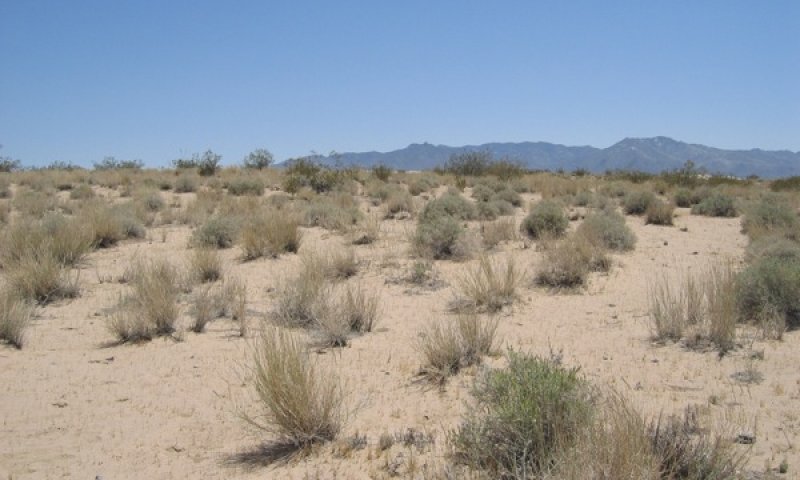

Natural Resources
Conservation Service
Ecological site R030XD008CA
Hyperthermic Sandhill
Last updated: 10/21/2024
Accessed: 12/22/2024
General information
Provisional. A provisional ecological site description has undergone quality control and quality assurance review. It contains a working state and transition model and enough information to identify the ecological site.

Figure 1. Mapped extent
Areas shown in blue indicate the maximum mapped extent of this ecological site. Other ecological sites likely occur within the highlighted areas. It is also possible for this ecological site to occur outside of highlighted areas if detailed soil survey has not been completed or recently updated.
MLRA notes
Major Land Resource Area (MLRA): 030X–Mojave Basin and Range
MLRA Description:
Major Land Resource Area (MLRA) 30, Mojave Desert, is found in southern California, southern Nevada, the extreme southwest corner of Utah and northwestern Arizona within the Basin and Range Province of the Intermontane Plateaus. The climate of the area is hot (primarily hyperthermic and thermic; however at higher elevations, generally above 5000 feet, mesic, cryic and frigid) and dry (aridic). Elevations range from below sea level to over 12,000 feet in the higher mountain areas found within the MLRA. Due to the extreme elevational range found within this MLRA, Land Resource Units (LRUs) were designated to group the MLRA into similar land units.
LRU notes
This Land Resource Unit (designated by ‘XD’) is found on the eastern side of California. Elevations range from 400 to 2200 feet on average, but may be found up to 3600 feet on southern exposures. Precipitation ranges from 1 to 6 inches per year, but averages between 2-4 inches. This LRU is characterized primarily by the extreme aridity, hot temperatures, hyperthermic soil temperatures and low stature of widely spaced vegetation. Temperatures can reach over 110 degrees Fahrenheit for several weeks in July and August. Summer precipitation falls between July and September, ranging from 20-33% in the form of rain, and winter precipitation falls starting in November and ends between February and March, ranging from 56-70%, also mostly in the form of rain. Vegetation is primarily small, widely-spaced, low-producing creosote bush (Larrea tridentata), burrobush (Ambrosia dumosa), and brittlebush (Encelia farinosa).
Classification relationships
This ecological site is found within the Pleuraphis rigida Herbaceous Alliance (Sawyer et al. 2009), and includes the Pleuraphis rigida/Larrea tridentata Association.
Ecological site concept
This ecological site is found on stabilized dunes and steep sandsheets at elevations ranging from 950 to 2620 feet, and slopes of 8 to 30 percent. Soils are very deep fine sands that formed from eolian deposits and exhibit no soil development.
The reference community is dominated by big galleta (Pleuraphis rigida), and creosote bush (Larrea tidentata), dyebush (Psorothamnus emoryi), and burrobush (Ambrosia dumosa) are common secondary species. Production reference value (RV) is 562 pounds per acre, and depending on precipitation and resulting annual forb production, ranges from 250 to 905 pounds per acre. Annual forbs are abundant during years of average to above average precipitation. Semi-stabilized, deep fine sands are optimum habitat for big galleta, which colonizes and stabilizes these eolian habitats with rhizomatous growth.
Data in the following sections is based on all components (major and minor) that are correlated with this ecological site.
Associated sites
| R030XA006CA |
Granitic Loam 5-7" p.z. R030XD006CA is found on adjacent fan aprons. Creosote bush (Larrea tridentata) is dominant. |
|---|---|
| R030XA025CA |
Saline Bottom R030XD025CA is found on adjacent sandsheets. Creosote bush (Larrea tridentata) is dominant and big galleta (Pleuraphis rigida) and Emory's dyebush (Psorothamnus emoryi) are important species. |
| R030XD001CA |
Hyperthermic Dry Hills R030XD001CA is found on adjacent hill and mountain slopes. Creosote bush (Larrea tridentata) and burrobush (Ambrosia dumosa) are dominant. |
| R030XD003CA |
Hyperthermic Steep South Slopes R030XD003CA is found on adjacent hill and mountain slopes. Brittlebush (Encelia farinosa) and creosote bush (Larrea tridentata) are dominant. |
| R030XD004CA |
Low-Production Hyperthermic Hills R030XD004CA is found on adjacent hillslopes. Creosote bush (Larrea tridentata) is dominant. |
| R030XD014CA |
Hyperthermic Sandy Plains R030XD014CA is found on adjacent sandsheets. Big galleta (Pleuraphis rigida) is dominant. |
| R030XY023CA |
Hyperthermic Dissected Shallow Pediment R030XD023CA is found on adjacent pediments. Mojave indigobush (Psorothamnus arborescens) and desertsenna (Senna armata) are dominant. |
| R030XD042CA |
Hyperthermic Shallow To Moderately Deep Fan Remnants R030XD042 is found on adjacent fan remnants. Vegetation is sparse and dominated by creosote bush (Larrea tridentata). |
Similar sites
| R030XD025CA |
Hyperthermic Sandsheets R030XD025CA is found on less steep sandsheets (slopes < 8 percent). Creosote bush (Larrea tridentata) dominates and big galleta (Pleuraphis rigida) and Emory's dyebush (Psorothamnus emoryi) are important species. |
|---|---|
| R030XD014CA |
Hyperthermic Sandy Plains R030XD014CA is found on less steep and less stable sandsheets. Production is higher and big galleta (Pleuraphis rigida) is dominant. |
Table 1. Dominant plant species
| Tree |
Not specified |
|---|---|
| Shrub |
(1) Larrea tridentata |
| Herbaceous |
(1) Pleuraphis rigida |
Click on box and path labels to scroll to the respective text.

